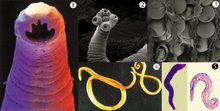HOOKWORM

(Ancylostoma spp. and Necator spp.)
Hookworm infection begins when the worm is in the larval stage. It penetrates the skin and migrates during its life cycle through the liver and the lungs, and it attaches to the mucosa of the small intestine where it matures. Hookworms deplete the body of nutrients, and a major effect is severe chronic iron-deficiency anemia.
Necator americanus, which ranges in size from 5 to 11 millimetres (0.2 to 0.4 inch), is responsible for about 90 percent of human hookworm infections that occur in tropical and subtropical regions of the world. Ancylostoma duodenale, 8 to 13 millimeters long, is found on all continents but is most prevalent in warm regions. A. braziliense, from 8 to 11 millimetres long, is normally parasitic in dogs and cats; man, however, is sometimes infected by this species in the southern United States, South America, and Asia. A. ceylanicum, normally parasitic in dogs, is sometimes found in man in South America and Asia. A. duodenale, possesses four hooklike teeth in its adult stage, and N. americanus has plates in its mouth rather than teeth.
Both species of hookworm have similar life cycles. The adult worm attaches itself to the mucosal tissue lining the small intestine, where the female may produce several thousands eggs a day, which are passed in the feces. If the fecal matter reaches suitable soil, the eggs are hatched, and the infective, threadlike larvae may penetrate human skin, usually that of the foot, by way of the sweat glands and hair follicles. They then invade the lymph and blood vessels, reach the lungs, and pass up the respiratory tree to reach the mouth, where they are swallowed and sent to the small intestine; there they mature and start a new reproductive cycle. The intestinal parasites are reputedly long-lived, with a lifetime that may span some 10 years.
The symptoms of hookworm disease ordinarily begin with ground itch, an itchy skin irritation caused by the larvae when they penetrate the skin and marked by papules and vesicles that are often located between the toes. In passing through the lungs, the larvae may produce coughing and fever. In the intestine, the mature worm sustains its life by bloodsucking, and persistent feeding by many worms over many years results in secondary anemia.
In heavy infestations (which may involve more than 500 larvae), the general symptoms include pallor of the skin and mucous membranes, fluid retention in the face and extremities, constipation alternating with diarrhea, abdominal tenderness, increased appetite for bulky or strange substances (e.g., clay), delayed puberty and stunted growth, fatigue, dullness, and apathy. Hookworm infestation tends to be constantly widespread in varied regions of the world.
Life Cycle Diagram

Eggs are passed in the stool , and under favorable conditions (moisture, warmth, shade), larvae hatch in 1 to 2 days. The released rhabditiform larvae grow in the feces and/or the soil , and after 5 to 10 days (and two molts) they become become filariform (third-stage) larvae that are infective These infective larvae can survive 3 to 4 weeks in favorable environmental conditions. On contact with the human host, the larvae penetrate the skin and are carried through the veins to the heart and then to the lungs. They penetrate into the pulmonary alveoli, ascend the bronchial tree to the pharynx, and are swallowed The larvae reach the small intestine, where they reside and mature into adults. Adult worms live in the lumen of the small intestine, where they attach to the intestinal wall with resultant blood loss by the host . Most adult worms are eliminated in 1 to 2 years, but longevity records can reach several years.
Some A. duodenale larvae, following penetration of the host skin, can become dormant (in the intestine or muscle). In addition, infection by A. duodenale may probably also occur by the oral and transmammary route. N. americanus, however, requires a transpulmonary migration phase.

The oral opening of this species contains
cutting "plates" as opposed to "teeth".

Hookworm Filariform Larvae
Shown at 100 ?m.
.

1 comment:
I'M TOTALLY FREE FROM HERPES VIRUS
Herpes is a serious and recurring condition that cannot be cured by drugs or injections by USA Doctors. But the best way to fight and get rid of herpes virus permanently is to take natural herbal remedies, I red about DR JAMES, the great hebal Doctor, who cures people of HIV virus with his powerful herbal medicine. I contacted him to find out how he could help me and he told me never to be worried that he would help me with the natural herbs medicine! After 2 days of contacting him he told me the medicine is ready and he sent it to me via DHL COURIER SERVICE and it got me in 3 days! I used the medication as he prescribed for me (MORNING and EVENING) and I was cured! It's really like a dream, but I'm so happy! For people suffering from the following diseases Eczema,Shingles,MS,Bullous Pemphigoid,Diabetes, cancer,Pcos, hypothyroidism,vaginal rashes, Herpes, COPD, HIV, arthritis, Hpv, liver disease, autoimmune diseases, Parkinson's disease, Lupus and more should contact him for his herbal medicine, because I am a living witness and I was cured of herpes virus. and DR James medicine is legitimate. I sent him what he asked for and he sent me his medication which I took for 2 weeks and today I am here with a negative result. When I went for the test, I was so happy after I took his herbal mix medicine.CONTACT DR JAMES FOR A PERMANENT CURE Email: drjamesherbalmix@gmail.com
He's a good man and he will help you
Post a Comment